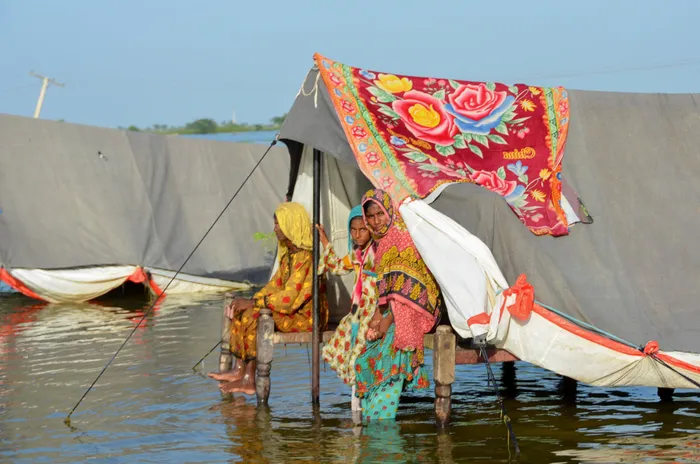Flood disaster adds to Pakistan’s economic woes

Picture: Amer Hussain/Reuters - Flood victims sit on a bed with their belongings as floodwater rises, after rains during the monsoon season in Sohbatpur, Pakistan this week. Melting glaciers are also contributing to further flooding in parts of the country.
By Gwinyai Regis Taruvingva
More than 33 million Pakistani citizens have been at the mercy of an unrelenting wave of rainfall which has caused severe flooding in the South Asian country. Such is the magnitude of the flooding that UN secretary-general António Guterres described the events as a “monsoon on steroids” in his bid to garner international support for Pakistan. The floods there continue to show the impact of climate change globally.
These floods also come at a time when other countries, such as the US, are battling wildfires because of sweltering heat waves in areas such as California. In Pakistan, more than 1300 people are believed to have lost their lives with a third of the country being underwater.
Extreme weather patterns have resulted in the country facing a two-pronged challenge – the first is some regions in the country face heat waves and other regions face extreme wet weather. Pakistan has several glaciers which have made the country prone to a climate change disaster.
The country contains the most glacial sites outside the polar regions. Areas such as Gilgit-Baltistan and Khyber Pakhtunkhwa are melting rapidly and have created more than 3000 lakes, some of which scientists believe could burst at any moment.
Although the Pakistani government, together with the international community, has mooted the installation of early warning systems, the potential of flooding remains a threat in Pakistan. With the advent of global warming, the air is becoming warmer, and this is one of the key contributors to the events in Pakistan.
Relief efforts driven towards assisting those affected by floods have been led by celebrities, organisations such as the UN, and the government of Pakistan. Singer Hadiqa Kiani has started a platform on Instagram, Vaseela-ERaah, which aims to provide victims with basic clothing, foodstuff, and necessities. Other celebrities in the country have used their platforms to raise awareness of the impacts of the floods.
In conjunction with Pakistan’s disaster management authorities, the UN High Commissioner for Refugees (UNHCR) has released tents, blankets, plastic sheets, buckets and other household necessities.
The flooding has decimated livelihoods as crops have been destroyed, with the UNHCR stating that 2 million hectares of land have been affected with more than 700 000 livestock having been destroyed. There is also fear that the flooding could result in the spread of water-borne diseases such as cholera.
Pakistan’s economy has also not been spared the impacts of the floods as the agriculture sector accounts for almost a quarter of the economy. According to the country’s central bank, the heavy rains are a downside risk to growth which was expected to be between 3% and 4%. Before the floods, Pakistan was already facing an economic downturn, which has since been exacerbated.
The country has secured some assistance from Arab countries and the International Monetary Fund (IMF) has approved the release of a $1.17 billion (R29bn) tranche bailout. The strenuous relationship between India and Pakistan has also been brought to the fore due to the flooding.
Under Imran Khan’s tenure as prime minister of Pakistan, trade with India was suspended in August 2019 and the two countries’ differing views on the Kashmir issue are some of the contributing factors to the diplomatic spats between them. Diplomatic tensions between the two countries are believed to be one of the key reasons that India has delayed its assistance to Pakistan.
It has been reported that India is prepared to send bilateral relief and aid to Pakistan as and when a request is granted. India and Pakistan are best placed to assist each other in cases such as the current floods, but the strained relationship between the two countries has hamstrung any such efforts.
Such is the state of the relationship that it took several days for the Indian prime minister to express condolences, which he did through a tweet. India has been at the forefront of many crises in the region, and it views itself as a “first responder”, which it has done often in countries like Nepal, Sri Lanka, the Maldives and Afghanistan.
The slow response by the Indian government is indicative of the relationship between the two countries. Pakistan’s finance minister, Miftah Ismail, has alluded to the impending food crisis in the country and noted that, if need be, the trade ban with India could be lifted to allow the country to import vegetables and edible items from India.
Sherry Rehman, Pakistan’s minister of climate change, announced that all three arms of the military have been deployed to alleviate the impacts of the flooding. However, even with that effort, the country remains overstretched.
When describing the events in Pakistan, Rehman notes that the storms were “some monstrous new phenomenon” – much worse than what the country witnessed in 2010. Although the government has tried to assist communities the crisis seems to be beyond its capacity, further making a strong case for countries like India to be of assistance.
The link between climate change and the floods in Pakistan remains inconclusive but they remain evident. Pakistan contributes less than 1% of global greenhouse gases and this has brought to the fore inequalities that are associated with climate change.
The patterns of extreme weather faced by Pakistan can strongly be linked to climate change. If further studies are anything to go by, events like those being witnessed in Pakistan shall continue to ravage smaller nations – with huge ramifications for citizens and economies.
Taruvinga is a post-doctoral research fellow at the Wits Humanities Graduate Centre